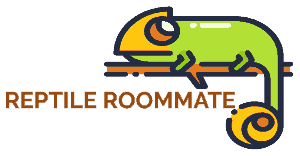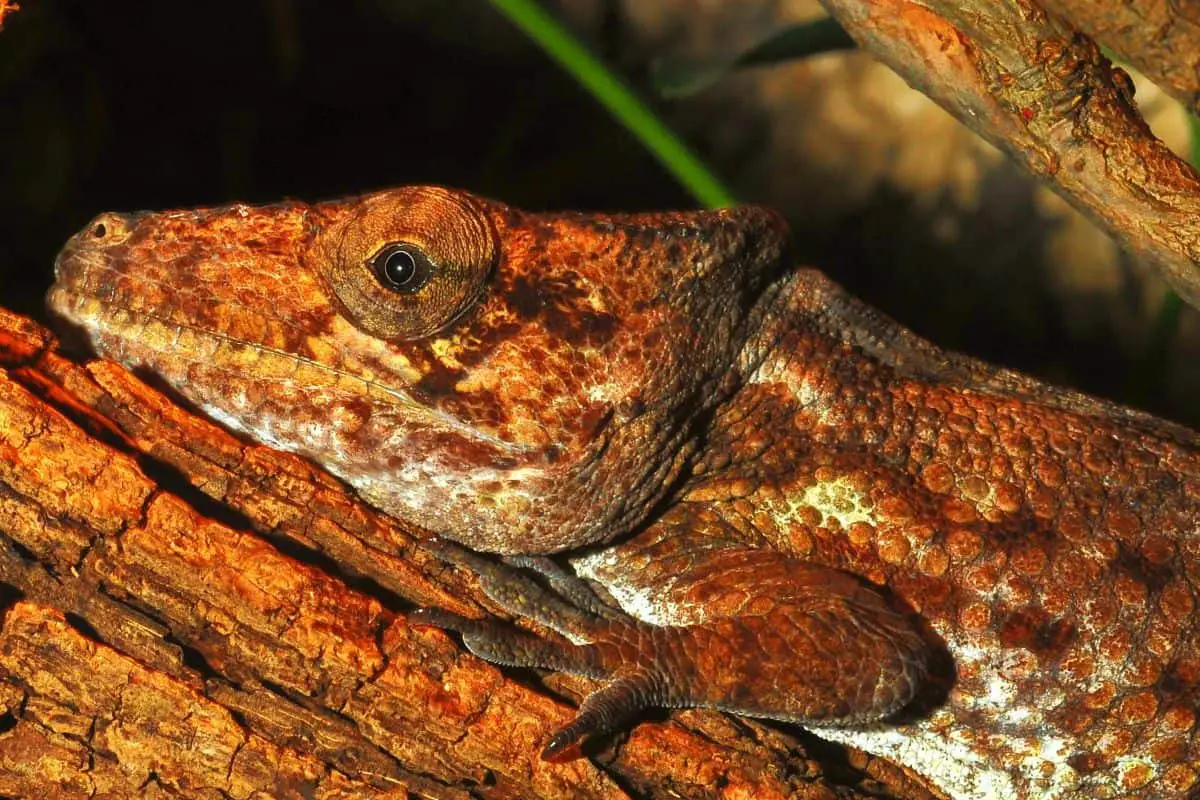The Bearded Anole Cuban False Chameleon Care Guide
Cuban False chameleons, or bearded anoles, are NOT related to chameleons; instead they are large members of the anole family and these lizards are more robust and forgiving than true chameleons can be.
Cuban false chameleons can make great pets! As long as you provide them with the following;
- minimum enclosure size of 18 x 18 x 24 inches
- full Spectrum UVB lighting
- 80% humidity
- ambient temperature between 73 and 78°F (23-26°C)
- basking area of 90°F (32°C)
Reptile Roommate is a participant in the Amazon Services LLC Associates Program. As an Amazon Associate I earn from qualifying purchases.
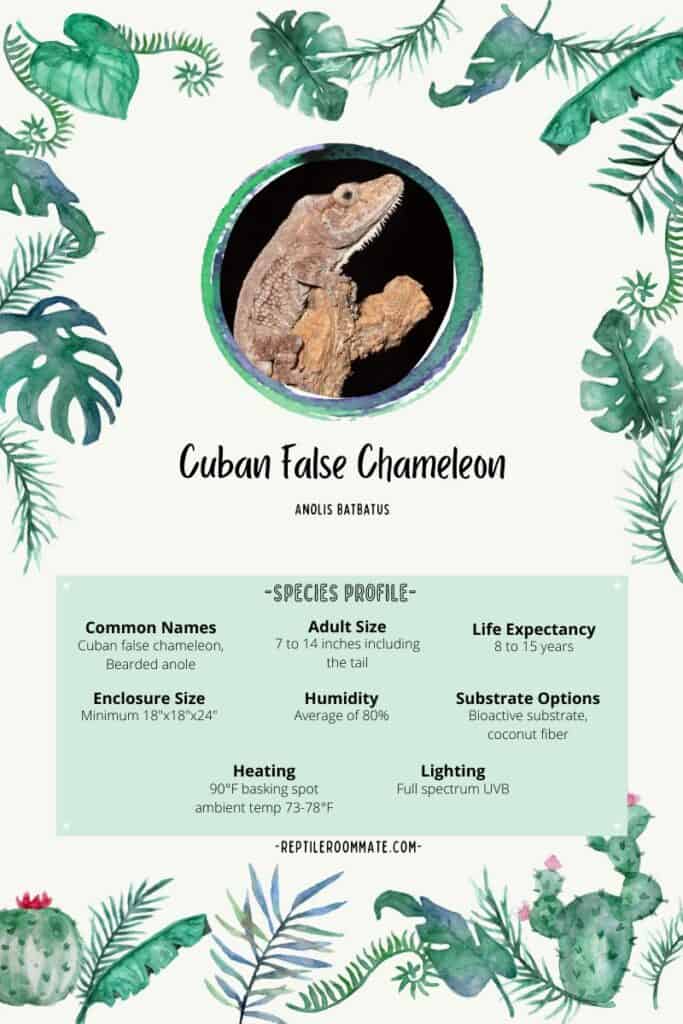
Are Cuban False Chameleons Real Chameleons?
Cuban false chameleons are named after the characteristics they have in common with true chameleons.
The false chameleon has eyes that can move independently and they are able to camouflage themselves and blend into their environment much the same as true chameleons.
False chameleons come in shades of brown, with varying amounts of white and green.
When fired up they can become so dark they look almost black in color. At other times they can become so light in color they look almost white in color!
Cuban false chameleons also share large, bony casques at the back of their skull and barb-like projections lining the bottom of their dewlap similar to those in chameleons.
What Are Cuban False Chameleons?
The Cuban False Chameleon belongs to the Chameleolis family which consists of 5 groups.
- Chameleolis aguero
- Anolis barbatus
- Anolis chamaeleonides
- Anolis guamuhaya
- Anolis porcus
This group of 5 anoles are all native to Cuba and are all considered false chameleons.
Fact: | Cuban false chameleons have (almost) completely black tongues!!
Cuban False chameleons are a large sized anole anywhere between 7 to 14 inches long from snout to tip of tail. (body length not including tail averages 6 inches)
Bearded anoles have limbs with long, extended fingers that help them to climb large trees much like iguanas.
Cuban false chameleons have large, almost disproportionately sized heads featuring bony casques and small blunt teeth, that help them crush snails and insects; staples of their diet.
An unusual characteristic for anoles, Cuban false chameleons lack the ability to autotomize (self amputate) their tails.
False Chameleons also have toe pads similar to geckos that help them climb and run on nearly any surface.
Fact: | Anoles possesses a “third eye.” This third eye isn’t for sight but for detecting light fluctuations which aid in warning the anole of flying predators overhead
Cuban false chameleons can live anywhere between 8 to 15 years in captivity provided they are given adequate care.
Do Cuban False Chameleons Bite?
False chameleons can be good pets for those intimidated by aggressive reptiles or those that are thought to be “biters” because they are very reluctant to bite you.
A Cuban false chameleon’s primary defense is to either get away, or if it absolutely has to, it tries to intimidate! They will bluff and try to make themselves appear opposing and threatening by facing right at you with their mouth open!
It takes A LOT to get a false chameleon to bite. However, it’s important to note these warning signs and be cautious or even step back a bit; this is the Cuban false chameleon’s last warning before a potential bite.
False chameleons do have powerful jaws and although their teeth are blunt, they can give a good pinch when pushed past their limits!
A bite may not break the skin, but they can hurt (especially if pinched on a sensitive area like the webbing of your fingers).
How Should You Handle a Cuban False Chameleon?
Handling a bearded anole, or false chameleon, is a breeze! Cuban false chameleons are very docile and can be handled without the fear of being bit or the chameleon making a run for it!
Spending a few minutes at a time multiple times a day works great towards socializing them.
When you do pick up your Cuban false chameleon it’s best to slowly do so by sliding your open hand underneath the lizard’s belly and let it “come to rest” on top of your palm.
Slowly remove it from its enclosure and remember to always be aware of your surroundings in case it decides to jump and you’re not prepared.
Being able to handle your false chameleon is something that every keeper looks forward to however, as with many reptiles however, less is truly more when it comes to handling.
Handling your cuban false chameleon a few times a week, for a couple minutes makes for a healthy and stress free situation!
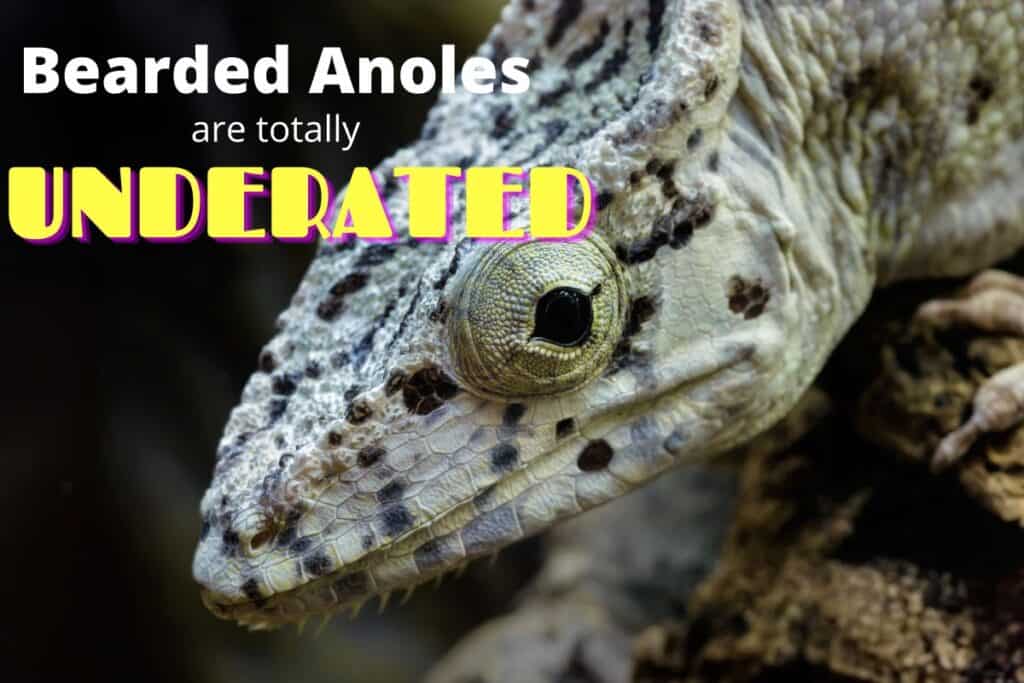
Are Bearded Anoles (False Chameleons) Good Pets?
Cuban false chameleons can make great pets! False chameleons are, hardy, good-tempered and docile, and being medium sized lizards, they don’t require extremely large enclosures like an iguana or monitor would.
As mentioned, false chameleons aren’t likely to be aggressive and bite, nor can they lose their tails like so many other lizards and geckos!
That said however, there are some unique requirements that need to be met in order to keep them long-lived and healthy.
What Enclosure for Cuban False Chameleons?
Cuban false chameleons are 6 to 7 inches in size and when including tail length they can be double that so they need an appropriately sized home!
For an individual Cuban false chameleon, it’s recommended their enclosure be, at minimum, 18” x 18” x 24.”
An enclosure such as the Zilla Bow Front Opening Terrarium would be ideal for a single specimen!
Glass terrariums or custom built glass enclosures are recommended because of the Cuban false chameleon’s high humidity requirements. (which we’ll touch on a bit later)
Cages or screened enclosures can have a difficult time meeting the humidity needs for these lizards depending on your climate.
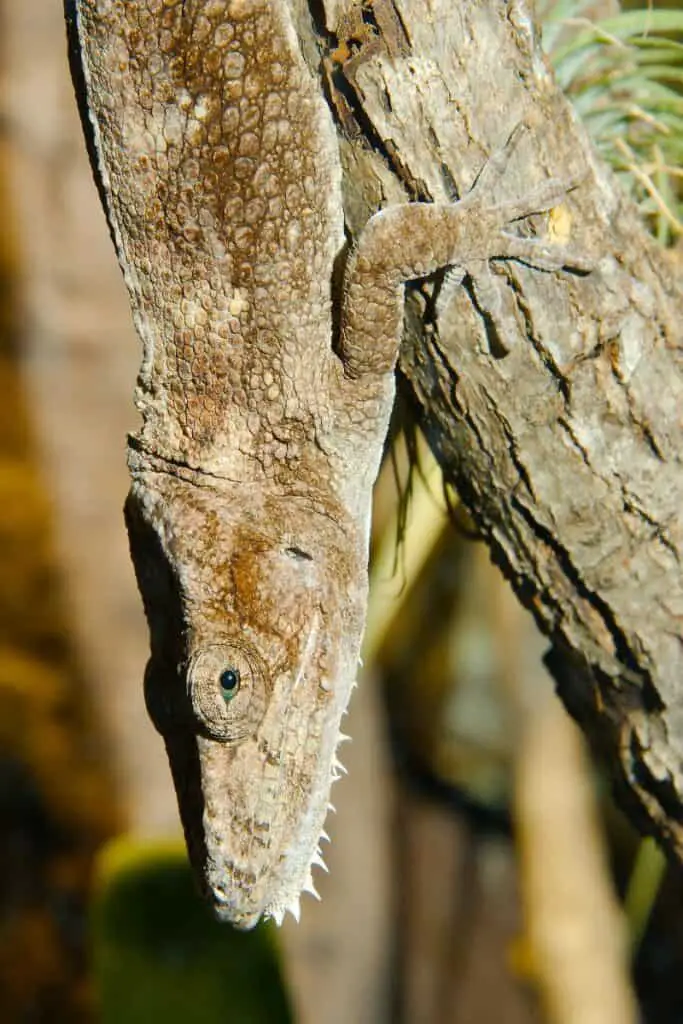
What Decor and Decorations for a Cuban False Chameleon Enclosure?
Your false chameleon’s enclosure should be filled with plants (live or artificial), branches, vines and substrate. Their natural habitat is full of plants, leaves, branches and vines. It resembles a ‘tangled mess’ of jungle.
This tangle of plants gives the Cuban false chameleon lots of cover and places to hide so that it feels safe and secure. Replicating their natural habitat to the best of our abilities should be the ideal that we strive to replicate.
Of special importance for a Cuba false chameleon is enclosure height and the ability to be off of the ground. False chameleons are arboreal lizards that live in the trees and as such need to have many branches, leaves and areas to perch on.
Live, large stemmed plants as well as those with big, heavy leaves are ideal for a Cuban false chameleon’s enclosure. (ficus, snake plants, croton, etc)
You can supply branches by using various types of driftwood or even artificial vines and branches.
Just be mindful of the high humidity needed in a false chameleons enclosure and its possible effects on soft woods. (potential for mold and rot) Aquarium safe driftwood is ideal!
Can Cuban False Chameleons Live Together?
Like many lizards, Cuban false chameleons can live together as either a male/female pair, a group of females, or a male/female/female trio.
The ONE RULE to follow is to NEVER house more than one male Cuban false chameleon together! Males should not even be ABLE TO SEE one another in separate enclosures!
…just being able to see another male will cause great stress for BOTH of the false chameleons.
Just keep in mind that when keeping multiple Cuban false chameleons in the same enclosure, you must increase the size of the habitat accordingly.
Each false chameleon needs its own “personal space” and room to “get away” if it wants. Overcrowding will cause stress and ultimately result in the deterioration of health.
A pair of Cuban false chameleons can be housed in an enclosure measuring 36” x 18” x 36” and a minimum size of 48” x 18” x 36” could accommodate a trio.
Tip: | Keeping more than one false chameleon together necessitates even more cover in the form of plants, branches, and hiding spots
Humidity and Water Requirements
Humidity and available drinking water go hand in hand in Cuban false chameleon setups.
The lack of proper humidity levels can lead to dehydration and giving your false chameleon water to drink is more complicated than offering it a simple water dish.
Humidity should be kept near 70% to 85+% in your Cuban false chameleon’s enclosure; which is quite high and can be difficult to maintain especially in mesh cage habitats.
Housing Cuban false chameleon enclosures will require frequent misting, to keep up humidity levels and to also provide an environment where the false chameleon can drink.
If humidity levels are high enough water droplets will form and gather on leaves in the enclosure and provide a means for them to drink.
Keeping up with the constant misting can be a chore, and for some, can prove nearly impossible.
A misting system can help alleviate this problem by automatically misting the enclosure on timed intervals, providing a constant level of humidity.
A second recommended item is a water dripping system.
These systems provide a means of constantly dripping water to give the false chameleons a source of drinking water that mimics how they drink in nature.
An added benefit to a drip system is that it can also provide extra moisture and help keep the enclosure at proper humidity levels.
It is important to not only keep humidity levels high, but also to keep them constant. You can achieve both by using a hygrometer.
Hygrometers will give you a reading of the humidity levels in your enclosure and you can adjust the frequency of your spraying or misting system to ensure proper levels.
It is preferable to use a digital hygrometer, avoiding the circular analog versions because they tend to be inaccurate.
What Substrate is Best for Cuban False Chameleons?
There are two popular “classes” of substrate used for Cuban false chameleon enclosures.
You should determine whether or not you are going to use a bioactive substrate or a “normal” substrate. A bioactive substrate will have various bacteria, isopods and springtails added as a ‘cleanup crew’ that help break down waste and keep the enclosure clean.
A non bioactive enclosure will have substrate that needs to be manually cleaned and replaced as necessary.
You can keep live plants in either type of enclosure, but most keepers that have bioactive setups use live plants
Bioactive
Pros
- Minimal maintenance cleaning needed because of the ‘cleanup crew’
- Live plants will help retain humidity
- Habitat will look more ‘realistic’
- Eliminates most smells that can result from waste, decaying matter
- Live plants will also help retain water droplets for drinking
Cons
- You need to purchase or acquire the cleanup crew in addition to other supplies
- You will need to provide appropriate substrate mix
- You will also now have plants that need to be taken care of each with their own unique requirements
- Generally bioactive setups are more expensive
Non-Bioactive
Pros
- As long as the substrate retains moisture, it doesn’t need to be complicated
- Artificial plants don’t need watering, pruning or get disease
- Provides a generally ‘easier’ option to get started
- Non-Bioactive setups are generally less expensive
Cons
- You need to manually remove waste, clean and change substrate as needed
- The potential for mold and harmful bacteria is greater in non-bioactive setups
- Artificial plants do not retain moisture and water droplets as well as live plants do
- For some, artificial plants do not look “realistic enough”
Non-Bioactive Substrate
When creating a non-bioactive enclosure with artificial plants, your substrate’s main job is to retain moisture and provide a surface from which you can clean up waste.
Coconut fiber and sphagnum moss do a great job of holding moisture and make for a simple substrate mix for non-bioactive habitats.
Bioactive Substrate
Bioactive substrates for Cuban false chameleons have distinct layers.
The bottom layer is a drainage layer consisting of porous rock or clay balls (provide beneficial bacteria and helps aerate the layers above) covered by a mesh layer to create a barrier between this drainage layer and the top layer of substrate.
The next layer is made up of a mixture of soil, sand and mulch which will be the home to some of your ‘cleanup crew.’ (springtails and bacteria)
The next layers are made of moss and leaf litter which help retain moisture and are home to the ‘cleanup crew’s’ isopods.
Below is a great video detailing how a bio-active substrate can be set up and created.
There are two versions shown ; a completely homemade bio-active substrate and a one using a commercial layer called ABG mix
Temperature For Cuban False Chameleons
Cuban false chameleons are from temperate climates and need the same when kept in captivity.
An ambient temperature between 73°F and 78°F during daytime hours with nighttime temperature drops between 70°F and 71°F are ideal.
While the ambient temperature needs to be kept in the high 70s, your Cuban false chameleon also requires a basking spot with a temperature @ 90°F.
This can be accomplished by using a splash proof halogen bulb like this one from Zoo Med. They are specially designed to be safe to use in humid conditions
During the day your basking lamp (set to @90°F) will most likely create a gradient throughout the enclosure and meet the ambient temperature requirements while in use.
During nighttime hours, while the basing lamp is turned off, you may require additional heating through the use of a ceramic heat emitter to maintain proper temperatures. These heat emitters do not disrupt the day/night cycle as they only emit heat.
(a ceramic heat emitter can also be used during the day for large enclosures where the basking lamp does not create enough heat in the furthest reaches of the habitat)
A must for any reptile keeper is a high quality thermostat for regulating temperature when using a ceramic heat emitter.
You can set the desired temperature with the thermostat and it will automatically adjust (increase and decrease) the amount of heat coming from your heat emitter and in order to maintain a constant temperature.
In order to accurately determine temperature in your Cuban false chameleon’s enclosure you’ll need to use a quality thermometer and/or a temp gun.
Lighting Requirements
Your Cuban false chameleon requires UVB light in order to synthesize calcium and vitamin D3. Setting up your UVB lighting to provide 10 to 12 hours a day is ideal.
If your false chameleon’s enclosure is filled with live plants, a great UVB / LED combination light such as the Reptisun LED UVB terrarium hood can be a great option.
This light provides the UVB that your Cuban false chameleon needs as well as the full spectrum lighting that the live plants crave.
Cuban False Chameleon Diet & Nutrition
In the wild snails are a staple food source in a Cuban false chameleon’s diet; along with many types of insects.
False chameleons have strong muscles in their jaws and head, along with blunt teeth, that they use while “rolling” entire snails (shell and all) around in their mouths to crack them open and eat them.
You can feed your Cuban false chameleons live snails, just be sure that the snails you source for food are disease and parasite free.
Sourcing healthy, live snails may prove difficult and so many keepers feed their Cuban false chameleons a combination of canned snails with shells removed and a variety of insects.
Some great feeder insects for Cuban false chameleons are:
- Dubia roaches
- Crickets
- Mealworms
- Silkworms
- Repashy Grub Pie
- Grasshoppers
- Caterpillars
- And wax worms (in moderation)
Calcium and Vitamin Supplementation
Feeder insects for your Cuban false chameleon should be dusted with calcium and vitamin supplements.
Feeding False Chameleons; Babies to Adults
Cuban false chameleons under 3 months of age should be fed every day. You can hand feed by offering the canned snails or dusted insects with a forceps.
Juvenile false chameleons can be offered food in such a way 3 to 4 times a week.
In addition to hand feeding your Cuban false chameleons, you should also provide a dish with feeder insects so that nutrition is available at all times of the day and night for all those under one year of age.
(an example would be 2-3 dubia roaches and a mealworm or two in their feeding dish at all times)
Adults older than one year can be hand fed 3-4 times a week without the need for additional nutrition in a feeding dish.
Cuban false chameleons tend not to overeat, so when they stop accepting food it usually means that mealtime is over.
Do Cuban False Chameleons Shed?
False chameleons will shed periodically throughout their lifetimes as they grow. Shedding is usually completed in a few hours, resulting in the Cuban false chameleons eating its own shed skin.
This is normal and perfectly fine for your false chameleon as the shed skin can provide beneficial nutrients.
Cuban false chameleons can have issues with stuck shed, especially around the eye or toes if humidity levels are too low.
Conclusion
As we’ve seen from this article Cuban false chameleons can make great pets! For many, they make much better pets than true chameleons!
“Cuban False Chameleon (Chamaeleolis chamaeleonides)” by Josh More is licensed under CC BY-NC-ND 2.0
